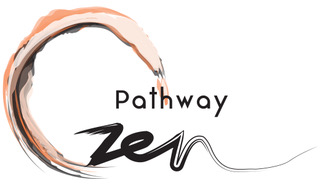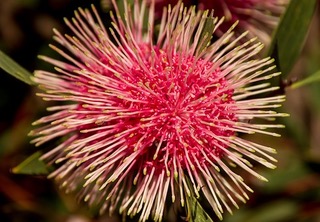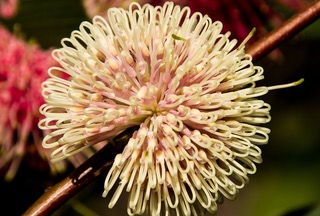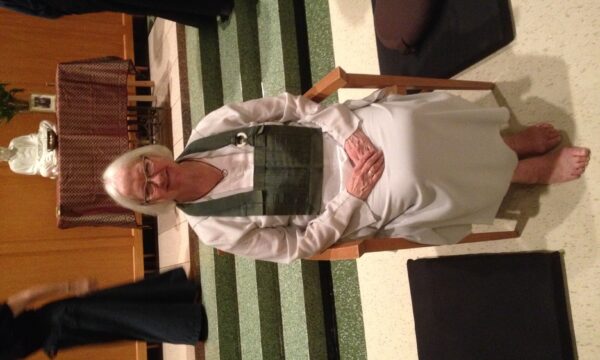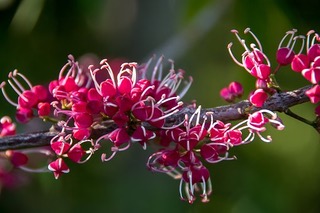Sanbō Zen lineage and history, compiled by Henry Shukman and Joan Rieck
Sanbō (Three Treasures) Zen
Sanbō Zen is an independent lay line of Zen Buddhism that blends elements of both the Caodong and Linji traditions in its teaching and practice. Its purpose is stated on its website (sanbō-zen.org) by the second abbot Yamada Kō’un Roshi (1907-1989) as follows:
The fundamental position of Sanbō Zen is to stand at the origin point of Buddhism through the Dharma gate of Dōgen Zenji.
Yamada explains that “the origin point of Buddhism” means Shakyamuni Buddha and his great enlightenment experience, and then continues:
. . . The purpose of our practice is to follow in the footsteps of Shakyamuni through correct zazen practice and to realize our true nature which is infinite and absolute; furthermore we aim to eradicate our attachment to enlightenment as such and keep making endless efforts to let our true self manifest itself in our personality and daily life. This is what is meant by “the Dharma gate of Dōgen Zenji.”
Through this actual practice we can attain true and ultimate peace of mind and come to foster spontaneously a deep Bodhisattva wish to share this joy with all other beings while constantly engaged in the great activities of purifying this world and the entire universe. In the Way of Zen, handed down through the Buddhas and Zen ancestors in the past, the way to actualize this great aim is traditionally established in a concrete and distinct manner—that is zazen. It is the ultimate aim of Sanbō Zen to contribute to steadily realizing true and everlasting peace among all people through this actual practice of zazen.
Sanbō Zen considers itself to be connected to Dōgen Zenji directly, rather than through the mediation of the Sōtō (Caodong) school in Japan. To understand how this came about, we first have to look at Dōgen’s own practice, training and teaching, and second, know something about Sanbō Zen’s founders.
Dōgen Zenji is famous for his promotion of the practice of shikantaza or “just-sitting,” and for his assertion that “practice is enlightenment; enlightenment is practice.” Yet this popular statement from Dōgen Zenji’s teachings may obscure another side to his own training and practice, which also surfaces extensively in his writings—namely that he was deeply schooled in “kanna Zen” or koan Zen, more commonly associated with the Rinzai (Linji) house of Zen.
1
Sanbō Zen
Dōgen Zenji’s own study of Buddhism began on Mount Hi’ei in Japan, where he trained with Tendai masters as a boy. He then took up the practice of Rinzai Zen at Tenninji in Kyoto under Eisai Zenji (1141-1215), who had studied in China. Eisai died a year after Dōgen met him, and Dōgen continued his training for several more years with a successor of Eisai, Myōzen (1184-1225), before traveling with him to China in 1223. Dōgen visited various temples on pilgrimage in China, and it was on his second visit to Tiantong Temple in 1225 that he finally met Tiantong Rujing Zenji (1163-1228) and, while training under him, experienced his great enlightenment of “body and mind falling away.” When Dōgen returned to Japan in 1927, he stayed once again at the Rinzai monastery Tenninji but left after three years, disappointed with the way training there had deteriorated in Myōzen’s absence. For the next three years, Dōgen lived alone in a suburb of Kyoto and continued writing his first teachings on Zen practice that he had already begun at Tenninji. Then, in 1233, he established his own training hall, Kōshō Temple, near Uji, Kyoto. Here he resided for ten years and took up the guidance of monks and lay people in earnest. Considering the early years of his training, it may be no surprise that Dōgen’s writings are filled with references to koans, or that he himself compiled a book of 300 traditional koans.
Although Dōgen is known as the founder of Sōtō Zen in Japan, it may be said that he also represents a confluence of the Rinzai and Sōtō approaches to Zen training. Yet even this may be misleading, since as Dōgen himself says, although there are five “houses of Zen” each one of them carries the complete “heart-seal of the mind of Buddha.” The division of Zen into separate houses took place as differences in views and emphasis developed among Zen teachers and their followers but, in a sense, there is only one Dharma, and all the houses express and maintain it.
Indeed, the mutual influence of Sōtō and Rinzai teaching on followers from both traditions is found repeatedly through Zen history. Shinji Kakushin (1207-1298), also known as National Teacher Hōtō, the Japanese successor of Linji Master Wumen Huikai (Mumon Ekai), first received the Bodhisattva Precepts from Dōgen Zenji, a Sōtō master. Although Kakushin did not train under Dōgen, the fact that he received the Bodhisattva Precepts from him evinces a special link between them. Kakushin later traveled to China and eventually received Dharma transmission as a Linji master in 1252. Later, Keizan Zenji (1267-1325), who was to become a co-founder of Japanese Sōtō Zen, studied with Shinji Kakushin. When Keizan founded Yokoji Monastery in 1312, a successor of Shinji Kakushin in turn received the Bodhisattva Precepts from Keizan, who was now a Sōtō Master. Later when Keizan resigned as head of Daijoji Monastery, he asked another successor of Shinji Kakushin, Kyōō Unryō, to take over for him as third abbot. These encounters indicate a deep mutual respect and trust between the traditions of Sōtō and Rinzai Zen at the time. When we come to the 20century and Sanbō Zen, we again see this kind of mutual respect in action. It could be said that Sanbō Zen exists as an embodiment of the inseparability of these two different methods and “houses” of Zen, just as Dōgen himself did.
Yasutani Haku’un (1885-1973) is the official founder of Sanbō Zen, an independent Zen line formerly known as Sanbō Kyōdan and often referred to as the “Harada-Yasutani School” because it is based on the teaching and practice that Yasutani received from his master, Harada Dai’un Sogaku Roshi (1871-1961). Both Harada and Yasutani were Sōtō monks.
Harada Dai’un Roshi entered a monastery at age seven and in his long career as a monk sought guidance from various Sōtō and Rinzai masters. He was named Dharma heir of the Sōtō master Harada Sodō Kakushin, and eventually became a student of Rinzai Master Kōgenshitsu Toyoda Dokutan, head of Nanzenji temple in Kyoto, under whom he completed koan study. In 1922, Harada was appointed head priest of Hosshinji in Obama, a small Sōtō temple that he built up into a vibrant training center. Having trained in both Sōtō and Rinzai Zen, he incorporated koan study in his teaching, which was uncommon for a Sōtō master in his day. He further departed from the conventions of his Zen school by writing a series of introductory talks on the practice of zazen for his students and by allowing lay practitioners to join the monks in training at Hosshinji. After World War II a number of foreigners came to him for guidance as well, including the German Jesuit priest Enomiya-Lassalle and the American author Philip Kapleau.
Harada Roshi was an outspoken critic of a faction of Sōtō teachers who promoted the idea that it was enough simply to believe in the Absolute Tathagata. He and his supporters held that belief alone was not enough, and that in the practice of the Buddha Way a personal experience of enlightenment was essential, a conviction which he stressed vigorously in his teaching. Yet Harada Roshi remained a Sōtō monk until his death.
Harada’s most well-known successor was Yasutani Haku’un. Born into a poor family, Yasutani was entrusted to the care of a temple at the age of five. He became a Sōtō monk at age 13 and was formally ordained a priest when he was 17. After subsequent years of training with masters at various temples, he decided to become a school teacher and worked as a substitute teacher for some years. In 1914 Yasutani graduated from Toshima Teachers’ School and began working at Kanda Graduate School in Tokyo. Meanwhile, he married and raised a family. Yasutani obtained the right to become a residential monk when he was 40 years old and set up a Dharma hall the next year. He was then appointed missionary for both main temples of the Sōtō sect. He wrote,
Although I traveled around and preached in the Tokyo and Kanagawa areas, my eye was not opened, and in my heart there was no peace. I was loath to tell lies and to bring the way in disorder, deceiving myself and others. At a time when I was suffering great discontent, I had the good karma to meet the teacher to whom I have become so indebted, Dai’un Shitsu Harada Sogaku Roshi. Finding a lamp in the darkness, I leaped for joy. I began going to the Roshi and received his severe guidance for a good 20 years, becoming able to distinguish beans from wheat a little concerning the gate of the Zen ancestors.
In 1925, at the age of 41, Yasutani attended Harada Roshi’s sesshin for the first time. His kensho was approved two years later at Hosshinji, and he continued to attend Harada Roshi’s bi-monthly sesshin there while serving as priest at various temples. In 1943, when he was 59 years old, and five years after finishing koan study with Harada Roshi, Yasutani Roshi received Dharma transmission from him.
Yasutani Roshi was to take up and carry on Harada Roshi’s pioneering spirit and reforming ardor. He supported Harada’s opposition to what he believed were erroneous interpretations of the Dharma by certain members of the Sōtō school and in 1931 wrote his first book Shōshin Mondō: Shōmakyō (A Dialogue about True Faith: Throwing Light on the Devil’s Mirror) to refute them. Over the years he continued to insist on the importance of both zazen and kensho in his teaching, and wrote numerous commentaries on koan texts. He also published a five-part commentary on Dōgen’s Shōbōgenzō, as well as many monographs, poems, articles and various publications. When he passed away in 1973, he left an unfinished commentary on the 300 koans collected by Dōgen Zenji.
In 1949 Yasutani Roshi established the zazen group Haku’un-kai in Hokkaido and led sesshin there for 24 years. In 1951 he founded the Sanbō Koryū-kai at Taiheiji Temple in Tokyo. The group’s periodical Kyōshō (Awakening Gong) was first published that year and continues to appear today as the official publication of Sanbō Zen. By 1952 there were 25 local groups, primarily in the greater Tokyo area, practicing zazen under the direction of Haku’un Roshi. The following year a Haku’un-kai was founded in Kamakura. Then in 1954, as Yamada Kō’un writes, Yasutani Roshi “finally gave up his membership in the Sōtō School and professed himself to be connected directly to Dōgen Zenji. It was certainly the inevitable outcome of his way.”
Yasutani Roshi’s organization Sanbō Kyōdan was legally recognized as an independent Zen Buddhist religious organization on January 81954. As had been the case under Harada Roshi, there were lay people and non-Japanese members from overseas among Yasutani’s students. He used his freedom as the founder of a new Zen school to institute Sanbō Kyōdan as a lay line with a simplified structure.
Yasutani felt that Zen practitioners would profit from engaging in both Sōtō and Rinzai practice. In the Preface to his book Shōyōroku Dokugo (Soliloquy on the Book of Equanimity), he writes about Masters Tahui Tsungkao (1089-1163) and Hongzhi Zhengjue (1091-1157) who were very close friends but held differing principles of guidance and views of Zen. They were uncompromising in their respective stances, which succeeding generations of their followers carried on. Yasutani writes:
. . . and so, as a matter of course, the distinguishing characters of Sōtō Zen and Rinzai Zen came to find their expression. On this score, I think that it would be highly desirable for Zen practitioners to study both the Hekigan-roku and the Shōyō-roku closely and acquire the strong points of both Rinzai and Sōtō Zen.
Yasutani goes on to say that when Hongzhi Zenji was dying, he placed all his affairs in the care of Dahui Zenji, and adds:
As successors to such wise men of old, we, too, should discard our sectarian egos, let go of prejudiced views, and learn the merits of both Sōtō and Rinzai.
In this regard, it is possible that Yasutani Roshi felt he was directly following the path of his ancestors Harada Dai’un Roshi and Dōgen Zenji, who likewise trained in both Sōtō and Rinzai Zen, and whose writings and teachings reflect that joint inheritance. Although Yasutani was sometimes critical of the Rinzai and Sōtō schools, he owed them much and expressed his deep gratitude to the many masters from whom he had received Dharma teaching during his long years of training. Following the example of Harada Roshi, he emphasized zazen and koan practice aimed at the attainment of kensho in his teaching, but he also taught the practices of breath counting, breath following and shikantaza (just sitting). The curriculum of koan study in Sanbō Zen includes the Sōtō texts Shōyōroku (Book of Equanimity), Denkōroku (The Transmission of Light), and Dongshan Liangjie’s (Tōzan Ryōkai’s) Go-I (Five Ranks), as well the Mumonkan (Gateless Gate), Hekiganroku (Blue Cliff Record) and koans from Hakuin Zenji used in Rinzai. Shikantaza is held up as the highest type of Zen practice in Sanbō Zen and especially recommended to students upon completion of koan study with a master.
In 1970, Yasutani Roshi resigned as the abbot of Sanbō Zen and was succeeded by Yamada Kō’un Roshi (1907-1989), who ten years earlier had been appointed one of Haku’un Roshi’s first Dharma successors. Yamada was a businessman with a family and remained a layman, traveling to work in Tokyo daily, as he took on the added responsibilities of Zen master. With the encouragement and support of his wife, Dr. Kazue Yamada, he built the small San’un (Three Clouds) Zendo within the family compound in Kamakura; it is still the main training hall of Sanbō Zen in the present day. Yamada remained close friends with his former roommate at Tokyo First High School, Nakagawa Sōen, who was instrumental in Yamada’s taking up the practice of zazen in the early 1940’s and became a well-known Rinzai master and haiku poet. Kō’un Roshi spoke English and carried on the tradition begun by Harada Dai’un Roshi of being open to sharing the Dharma with all seekers of good will, accepting as students people of other national and religious backgrounds who came to him for guidance. Among them were highly motivated Christian pastors, priests and nuns, a number of whom later received permission from him to lead others in Zen practice. Kō’un Roshi often spoke and wrote of his desire to help people around the world experience their ‘common ground,’ the essential nature, through the practice of zazen. He felt that anyone with a human nature could practice Zen, and that it was the true way to achieve lasting peace in the world.
The third abbot of Sanbō Zen, Kubota Ji’un Roshi (1932–) is a former businessman who has lived and worked in the West. He began practicing Zen as a teenager after his brother died at a young age and trained under both Haku’un Roshi and Kō’un Roshi, eventually receiving Dharma transmission from both. Following Kōun Roshi’s death in 1989, Kubota Roshi became the head of Sanbō Zen and served as abbot for 15 years, carrying on the school’s emphasis on the practice of zazen, koan study, and coming to realization.
In 2000, as abbot of Sanbō Zen, Kubota Roshi published an apology in the Kyōshō for Yasutani Haku’un Roshi’s repeated promotion of the Japanese military during World War II and his voicing of right-wing and anti-Semitic ideology, both during and after the war. After continuing to teach Zen in Tokyo and Germany for years, Kubota Roshi retired this year, 2014, from all official teaching activities of Sanbo Zen on account of his advanced age.
The present abbot of Sanbō Zen is Yamada Ryō’un Roshi (1940–), who works as a businessman along with his duties as head of the Zen school. Ryō’un Roshi began Zen practice under Yasutani Roshi at the age of 16, when his father–who later became Kō’un Roshi–was also Yasutani’s student. After Yasutani’s retirement, he continued his Zen training under the guidance of his father and received Dharma transmission from him. In 2004, Ryō’un Roshi succeeded Kubota Roshi as abbot. He travels frequently to Sanbō Zen centers around the world to hold sesshin and continue the work of spreading the Dharma received through the teaching of Harada Roshi and Yasutani Roshi, and carried on by Yamada Kō’un Roshi and Kubota Ji’un Roshi.
In general, Sanbō Zen has an emphasis on two things: zazen practice itself, and a clear experience of kensho or awakening, which can then be further deepened and clarified through ongoing zazen and koan study with a teacher. The school has less emphasis on ritual and the traditional trappings of monastic Zen practice, which in turn serves its history and identity as a line open not only to lay practitioners, but to people of any or no religious affiliation.
In spite of being a small Zen school in Japan, through the pioneering work of its abbots, Sanbō Zen has come to have an influence far afield, in Europe, North America, the Philippines, Australia and Singapore. In the 1960’s Yasutani traveled to the United States seven times to hold sesshin and give Dharma talks. Yamada Kō’un in his time also taught abroad and authorized some dozen westerners to teach Zen; they have now trained a new generation of western teachers in fifteen countries, all of them also sanctioned by later abbots of the organization. There are around 3,000 students within the organization worldwide. In addition, several other overseas lines of Zen derive from Sanbō Zen, such as the Diamond Sangha and White Plum Asanga in North America and Australia, and the Willigas Jaeger line in Germany. Today, Sanbō Zen is restructuring itself in order to support the international nature of its activities.
Joan Rieck and Henry Shukman
